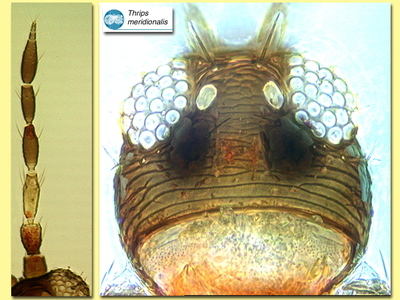Figures
Fig. 1 Antenna and head (dorsal)
Fig. 2 Pronotum
Fig. 3 Meso- and metathorax
Fig. 4 Fore and hind wing
Fig. 5 Sternite VI and VII
Fig. 6 Tergite VIII
Species
Thrips meridionalis Priesner
Biology
Flower living, and causing damage to the flowers and fruits of stone fruits in southern Europe.
Distribution
Throughout Mediterranean countries.
Recognition
Medium to large, dark brown thrips, antennal segment III usually yellow; forewings brown with base sharply white. Antennae 8-segmented, sense cone on III & IV small and forked. Head with no setae in front of fore ocellus, one pair of major setae on anterior margins of ocellar triangle. Pronotum with 2 pairs of posteroangular setae. Metanotum with transverse lines at anterior but longitudinal lines on posterior half; median setae not at anterior margin. Forewing first vein with 3 or 4 setae on distal half. Tergite II with 3 lateral marginal setae; V-VIII with ctenidia laterally, on VIII posteromesad of spiracle; posteromarginal comb on tergite VIII complete with slender microtrichia. Sternites with transverse row of about 12 discal setae; pleurotergites with 1, 2 or 3 discal setae.
Related species
Closely similar in structure to the northern European species T. vulgatissimus, of which it possibly represents merely a Mediterranean biological strain.







